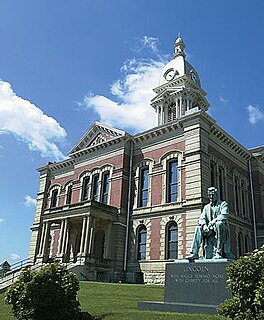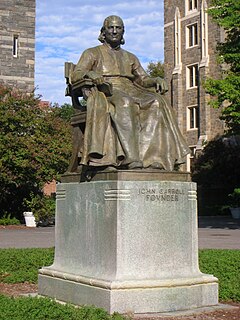
The Statue of Freedom, also known as Armed Freedom or simply Freedom, is a bronze statue designed by Thomas Crawford (1814–1857) that, since 1863, has crowned the dome of the U.S. Capitol building in Washington, D.C. Originally named Freedom Triumphant in War and Peace, a U.S. government publication now states that the statue "is officially known as the Statue of Freedom". The statue depicts a female figure bearing a military helmet and holding a sheathed sword in her right hand and a laurel wreath and shield in her left.

William Jones Lowndes was an American lawyer, planter, and politician from South Carolina. He represented the state in the U.S. Congress from 1811 to May 8, 1822, when he resigned for health reasons.

James Earle Fraser was an American sculptor during the first half of the 20th century. His work is integral to many of Washington, D.C.'s most iconic structures.

There are many outdoor sculptures in Washington, D.C. In addition to the capital's most famous monuments and memorials, many figures recognized as national heroes have been posthumously awarded with his or her own statue in a park or public square. Some figures appear on several statues: Abraham Lincoln, for example, has at least three likenesses, including those at the Lincoln Memorial, in Lincoln Park, and the old Superior Court of the District of Columbia. A number of international figures, such as Mohandas Gandhi, have also been immortalized with statues. The Statue of Freedom is a 19½-foot tall allegorical statue that rests atop the United States Capitol dome.

Franklin Bachelder Simmons was a prominent American sculptor of the nineteenth century. Three of his statues are in the National Statuary Hall Collection, three of his busts are in the United States Senate Vice Presidential Bust Collection, and his statue of Ulysses S. Grant is in the United States Capitol Rotunda.
Philip Reid was an African American master craftsman and artisan who played a key role as the foreman in the casting of the Statue of Freedom sculpture atop the United States Capitol building in Washington D.C. He was born into slavery in South Carolina's historic city of Charleston.

John Fraser was a Scottish-born American architect who practiced in Philadelphia, Pennsylvania and Washington, D.C.

The Treasury Building in Washington, D.C., is a National Historic Landmark building which is the headquarters of the United States Department of the Treasury. An image of the Treasury Building is featured on the back of the United States ten-dollar bill.

The Lincoln Monument of Wabash, Indiana or The Great Emancipator is a public sculpture by Charles Keck, a sculptor who was born in New York City. The cast bronze sculpture was commissioned by Wabash-native Alexander New and donated to the city of Wabash, Indiana, in 1932. It has remained on view at the northeast corner of the Wabash County Courthouse lawn ever since.
Roman Bronze Works, now operated as Roman Bronze Studios, is a bronze foundry in New York City. Established in 1897 by Riccardo Bertelli, it was the first American foundry to specialize in the lost-wax casting method, and was the country's pre-eminent art foundry during the American Renaissance.

Bishop John Carroll is a statue by the sculptor Jerome Connor commemorating Archbishop John Carroll, the founder of Georgetown University and the first Catholic bishop in the United States. Located in front of Healy Hall, on university's campus in the Georgetown neighborhood of Washington, D.C., the statue consists of a bronze sculpture of Carroll atop a granite pedestal.

Commodore John Barry is a bronze statue of John Barry, by John Boyle.

Albert Gallatin is a bronze statue by James Earle Fraser. It is located north of the Treasury Building, at 15th Street and Pennsylvania Avenue, N.W. Washington, D.C. It was authorized by Congress on January 11, 1927. It was dedicated on October 15, 1947.

The Darlington Memorial Fountain is a gilded bronze statue by C. Paul Jennewein. It is located at Judiciary Park at 5th Street and D Street, Northwest, Washington, D.C., in the Judiciary Square neighborhood.

The Arts of War and The Arts of Peace are bronze, fire-gilded statue groups on Lincoln Memorial Circle in West Potomac Park in Washington, D.C., in the United States. Commissioned in 1929 to complement the plaza constructed on the east side of the Lincoln Memorial as part of the Arlington Memorial Bridge approaches, their completion was delayed until 1939 for budgetary reasons. The models were placed into storage, and the statues not cast until 1950. They were erected in 1951, and repaired in 1974.

Alexander Hamilton is a marble bust portrait of Alexander Hamilton, done in the style of a Roman Senator, by the Italian sculptor Giuseppe Ceracchi. Ceracchi also created many replicas, in both marble and plaster. The bust was later used as a model for sculptures and paintings.

Harvey W. Scott, or simply Harvey Scott, is a 1933 bronze sculpture by Gutzon Borglum depicting American pioneer, newspaper editor and historian Harvey W. Scott, located at Mount Tabor Park in the Mount Tabor neighborhood of Portland, Oregon.

John McLoughlin, also known as Dr. John McLoughlin, is a bronze sculpture of John McLoughlin by Alexander Phimister Proctor and completed by his son Gifford MacGregor Proctor. One statue is installed at the Oregon State Capitol grounds in Salem, Oregon; another is installed in Washington, D.C., as part of the National Statuary Hall Collection.
Thomas Jefferson is one of several versions of a statue of Thomas Jefferson executed by Karl Bitter.























